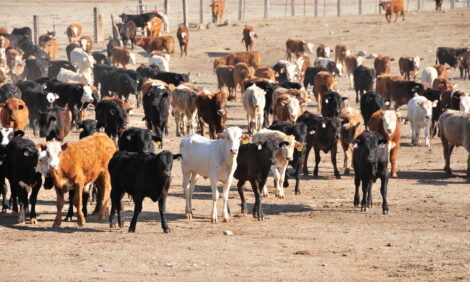



MLA: Weekly Cattle Summary
AUSTRALIA - This report is a collection of weekly cattle price summaries from each Australian territory by Meat & Livestock Australia (MLA).
South Australia
Only one sale
Mt. Gambier was the states’ only NLRS reported market this week, due to the SA LE having another Monday public holiday off, and Naracoorte’s saleyards improvements causing a closure. With SA’s major processors being fully booked for another 3 to 4 weeks, it has made it even more difficult for producers to sell their cattle.
Direct prices have remained reasonably stable despite the fluctuating saleyard prices.
Mt. Gambier’s smaller yarding featured improved quality runs of young cattle and grown steers that sold to strong SA and Victorian trade and export competition. Feeders and restockers were active, albeit only able to source limited numbers. Most cows were dearer, with only some 2 scores being cheaper due to a general lack of any restocker activity.
Improved Quality, Improved Prices
With the limited number of cattle available this week, the improved quality at Mt. Gambier led to improved prices generally being paid.
Three C2 and B1 vealer steers to the trade sold from 130¢ and 180¢; with the four C2 vealer heifers at 150¢ and 182¢/kg. Restockers purchased lightweight C2 vealers steers at 140¢ and 161¢/kg. The C3 and B2 yearling steers were 6¢ to 11¢ dearer, selling from 178¢ to 198¢/kg to very strong wholesale competition. The medium and heavy C3 and C4 yearling heifers followed suit, as they sold from 177¢ to 198¢ to be 6¢ to 15¢/kg dearer. Feeder and restockers sourced C2 light and medium weight heifers from 116¢ to 172¢, or unchanged to 33¢/kg dearer.
Grown steers and bullocks sold from 155¢ to 198¢, with C2 sales unchanged while being 13¢ to 15¢/kg dearer for the C3 steers. A pen of well-bred heavy Friesian steers sold at 135¢/kg at dearer levels. Most 3 to 6 score beef cows were 1¢ to 7¢ dearer, selling between 106¢ to 130¢/kg. However, the 2 scores to processors and a restocker were 4¢ cheaper selling from 87¢ to 116¢/kg.
Queensland
Supply increases
The short working week due to the public holiday had no effect on supply. The return of the fortnightly Longreach sale, and a lift of 30 per cent in numbers at both the Roma and Dalby markets, boosted supply at physical markets covered by MLA’s NLRS by 57 per cent .
Young cattle continued to dominate the selling pens at most centres, with producers in the drier areas continuing to offload stock as the season deteriorates. Heavy grown steers and bullocks remain scarce, while a larger numbers of cows in the lower fat score range were penned. Young cattle experienced improved buyer activity with the return of supermarket competition along with some southern influence.
Buyer representation for grown cattle was good and included all the major export processors.
Buyers remain active
Light rain across the eastern districts continues to lift restocker enthusiasm, with lightweight young cattle improving a further 4¢ to 13¢/kg. A fair sample of vealer steers were returning to the paddock at 185¢, with sales to 195.2¢/kg.
Rain in southern states improved demand on vealer heifers to slaughter and average prices lifted by 4¢ to 151¢/kg. Restocker lines gained 11¢ to average 155¢/kg. Over 3,000 head of lightweight yearling steers returned to the paddock at firm rates to average 174¢, and D muscle lines generally sold around 143¢/kg.
Feeder buyers remained active; medium weight yearling steers averaged 165¢ and heavyweights 154¢, with the occasional sale to 179.2¢/kg. Lightweight yearling heifers mostly sold in the early 150¢/kg range.
Heavy grown steers to export slaughter averaged 158¢ and sold to 175.2¢/kg. Bullocks made to the very occasional 174.2¢ with most at 159¢/kg. A line of heavy grown steers and bullocks out of the feedlot returned for more time on grain to make 165.2¢/kg.
Cows experienced a mixed trend with plain condition lines receiving very solid support from processors and restockers to remain fully firm with most sales from 82¢ to 90¢/kg. However, good heavy cows could not maintain the improved rates of the previous week and lost 5¢ to average 120¢ with sales to 137.2¢/kg.
Western Australia
Strong season in the south
Unseasonal weather conditions have persisted in the far north of WA, with areas of the Kimberly and Pilbara remaining wet. This has hampered both mustering and transport activity out of these areas, however the disruption should only be short lived.
The traditional cattle grazing areas of the southern land division enjoyed further rainfall early in the week, further enhancing solid seasonal conditions. Feed levels remain high and are well above average normally seen at this time of year in the southwest.
Numbers remain moderate
Cattle numbers remained moderate with both Muchea and the southwest sales having only limited supplies. The Great Southern sale remained the largest of the three weekly markets. Supplies of pastoral cattle remained limited in saleyards, while processors continued to enjoy good numbers from these areas.
The volumes of prime trade steers, heavy weight steers and heifers remained limited with the majority of cattle sales made up for by young local store classes. Cow numbers remained fair and moderate.
There was little change in competition for prime grades of heavy weight trade steers and heifers, with processor and retailer demand maintained. Young store grades continued to enjoy a very solid demand from both the feeder and restocker sectors, with firm prices generally realised throughout the classes.
Demand from the processing sector saw marginal improvement this week in cow categories with the market recovering some of the losses of the previous week. This was also the case in heavy weight bull categories, while live exporters remained selective in their purchases of lightweight and vealer bulls with the majority purchased by export feeders.
New South Wales
Consignments slip back
Consignments slipped 48 per cent week on week with substantial rainfalls the contributing factor. In addition, the larger selling centres of Wagga along with Tamworth were cancelled due to the holiday weekend.
Singleton and Gunnedah defied the trend to lift 24 per cent and 12 per cent respectively, while the harsher winter conditions at Goulburn also produced larger numbers. Rainfall throughout the western regions produced the smallest yarding at Dubbo for many years, with only 273 cattle offered.
Quality continues to be mixed
The majority of markets reported mixed quality offerings, however CTLX, Carcoar and Scone reported good numbers of prime younger cattle. Younger cattle again dominated market percentages as the cow categories made up the bulk of the older cattle.
Vealer steers and heifers were represented by similar numbers as the yearling steers far outnumbered the heifer portion. Prime conditioned heavy weight steers and bullocks along with grown heifers continue to be limited in supply. Cow numbers slipped back for a small total of 1,101 yarded at MLA’s NLRS markets.
Values sold to mixed trends
Vealer steers and heifers to restocker and feeder orders sold close enough to firm as well-bred and finished heavy weights to butcher orders sold at a premium. Medium weight vealer steers returning to the paddock averaged 166¢/kg. The same weighted heifer portion to the trade reached 176¢, with most selling around the 151¢/kg range.
Yearling steers and heifers to restock and feed remained firm, with only quality contributing to price variations. Prime heavy weight grown steers and bullocks remained around equal as younger drafts reached 185¢/kg. Cows trended cheaper to average 3¢ to 4¢/kg lower week on week. The plainer 2 scores averaged 85¢, while the better covered 3 and 4 scores ranged from 75¢ to 125¢/kg.
Victoria
Reduced yardings
The combined yardings totalled 8,500 head, a very similar number to that of the previous week. Monday’s public holiday saw Ballarat and Pakenham not operating which would have seen last week total exceeded.
Big falls of over 100mm of rain were recorded by Thursday in Gippsland, with more rain and local flooding forecast before the weekend. Western District markets all offered fewer cattle surprisingly as rainfall was not as wide spread in these parts.
Quality mainly dictates price again
Quality at nearly all markets was again plain this week. The Western District yardings ranged from mainly poor to average at best, while Leongatha’s sale was improved but still mixed. Price trends amongst categories did fluctuate a lot more this week however young cattle saw a clearer pattern.
Generally, the better quality young cattle were firm to dearer and the poor to plain quality eased. There were increased supplies of plain light weight young cattle at Wodonga while Leongatha yarded a larger and better quality penning of grass-fed yearlings.
The grown steers amongst individual markets varied either side of equal by an average of 2¢ to 3¢/kg. Cows were anywhere from 5¢ easier earlier in the week at Western District markets and up 10¢ to 12¢/kg at the other centres.
Buyers still keen to purchase
Most of the usual buyers were operating at markets this week, though the current lack of quality has buyers hesitant to purchase secondary lines. At Wodonga southern buyers were very strong as they look to secure numbers and hopefully an increase in quality not seen in their regions. Restocker activity and presence varied widely amongst markets with the better competition present at Wodonga.
TheCattleSite News Desk


